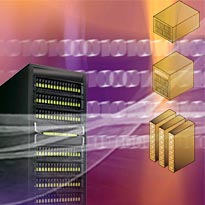Portal:Storage
From Wikibon
| Line 43: | Line 43: | ||
</p> | </p> | ||
[[Storage virtualization design and deployment | read more...]] | [[Storage virtualization design and deployment | read more...]] | ||
| - | |}[[Category:Backup and restore]][[Category: Blade computing]][[Category: Business compliance]][[Category: CDP]][[Category: Careers]][[Category: Careers wikitips]][[Category: Clustered storage]][[Category: Compliance and | + | |}[[Category:Backup and restore]][[Category: Blade computing]][[Category: Business compliance]][[Category: CDP]][[Category: Careers]][[Category: Careers wikitips]][[Category: Clustered storage]][[Category: Compliance and discovery]][[Category: Enterprise mobile wikitips]] |
Current revision as of 00:18, 23 February 2010
The Wikibon Data Storage Portal contains data storage industry research, articles, expert opinion, case studies, and data storage company profiles.
Latest Information Storage Research
| >>Join our Group | >>Become a Fan | >>Follow @Wikibon | >>Read the Blog | ||||
WikitipMobility, Collaboration and BYODTechnology helps to transform how and where people work. Today’s business is about mobility, real-time collaboration, and a globally dispersed workforce. Leveraging that technology -whether it be video, smartphones, tablets, speech recognition, presence management or social media -to provide instant communication and collaboration within a company, as well as communicating with customers and prospects alike- is key and becoming increasingly based upon personal attitudes and choice. Businesses and users continue to migrate away from inefficient and expensive legacy platforms of the past-mobility is as much about the technology as well as folks attitudes and behavior towards it. Mobility via Speech Technology Old directory-trees, spell-the-name directories, and voicemail systems are no longer effective for employees and customers that are using various mobile devices and connecting from remote locations. They are time wasters. Speech technology has been around for a while and today’s speech technology helps callers locate, communicate and collaborate in real time-even bringing those legacy systems into relevancy via speech. Speech is no longer a nice to have-but a have to have. Speech Technology keeps mobile employees and customers connected and for enterprises-creates a numberless enterprise: With solutions like Mobiso, speech technology provides the simplicity to call, message or conference by simply speaking the name of the person, product or team they want to reach – no thumbling on various keyboards required! Safety is key here too. Voice messages are able to be translated into text and can be delivered to the recipient in their preferred method – via email alerts or SMS messaging. Recipients can now efficiently review and manage content, easily retrieve messages with mobile devices, and avoid manual transcription of items like names, phone numbers, and addresses. Real Time Collaboration & Enterprise Integration Expensive software & hardware frameworks are no longer required to offer seamless communication tools, or host video conference features. Cloud-based business communications providers offer web based systems for businesses providing access to voice services, video conferencing and contact centers for a monthly price and even for free in some cases. Spoken words can be translated to text and typed words converted to speech, creating a seamless communications experience for all parties. Presence-aware help desks, integrated contact center solutions, and other applications that can be accessed by a variety of business partners and clients – help to make keypads obsolete. Invoking these valuable UC services with Mobiso’s speech technology make those connections smarter and more efficient. Dispersed Workforce and BYOD Whether you’re a global enterprise or an SMB, you’re most likely challenged with providing unified communication solutions for remote workers, multiple locations, home offices, partners and sales channels. With a dispersed workforce comes the additional issues of supporting a Bring Your Own Device(BYOD) environment. Your employees and customers are using diverse devices to contact you and access your data. Solutions like Mobiso’s suite of software and services provide cross-platform, cloud-based support for your voice and data transactions, including: BYOD flexibility: mobile endpoint devices provide greater flexibility in all call handling and messaging for both person-to-person and business contacts, including valuable syncing and updates of both personal and business contacts. Replacing paper-based processes with mobile-friendly applications, such as Mobiso’s Wireless Expense Management to manage the ever escalating costs of mobility-including real time alerting and separation of business vs. personal usage. Mobiso’s cloud-based speech technology makes speech a requirement regardless of device to compete and integrates with Broadsoft, Genband, Metaswitch, Asterisk, Avaya, Cisco and Mitel communication platforms to create a truly seamless and smarter workplace. UC Continues to Evolve Many enterprise and SMB’s are already enjoying the benefits of Unified Communication solutions integrated with business applications and processes. UC solutions have evolved to improve employee productivity, improve your company’s customer service, and make it easier for your customers and partners to do business with you. Invoking these valuable solutions with Mobiso’s speech technology makes them that much more valuable and complete. Personal device choice and behaviors by employees and customers continue to influence UC’s evolution, driving the technologies to support them. Mobiso, by Lyrix, is a leading cloud based software solutions provider. To learn how affordable Mobiso’s suite of services are, with specific ROI examples for your industry, be sure to request a free trial of Mobiso for your enterprise. |
Featured Case StudyVirtualization Energizes Cal State UniversityJohn Charles is the CIO of California State University, East Bay (CSUEB) and Rich Avila is Director, Server & Network Operations. In late 2007 they were both looking down the barrel of a gun. The total amount of power being used in the data center was 67KVA. The maximum power from the current plant was 75kVA. PG&E had informed them that no more power could be delivered. They would be out of power in less than six months. A new data center was planned, but would not be available for two years. |
|
Featured How-To Note |
Storage Virtualization Design and DeploymentA main impediment to storage virtualization is the lack of multiple storage vendor (heterogeneous) support within available virtualization technologies. This inhibits deployment across a data center. The only practical approach is either to implement a single vendor solution across the whole of the data center (practical only for small and some medium size data centers) or to implement virtualization in one or more of the largest storage pools within a data center. | |||



